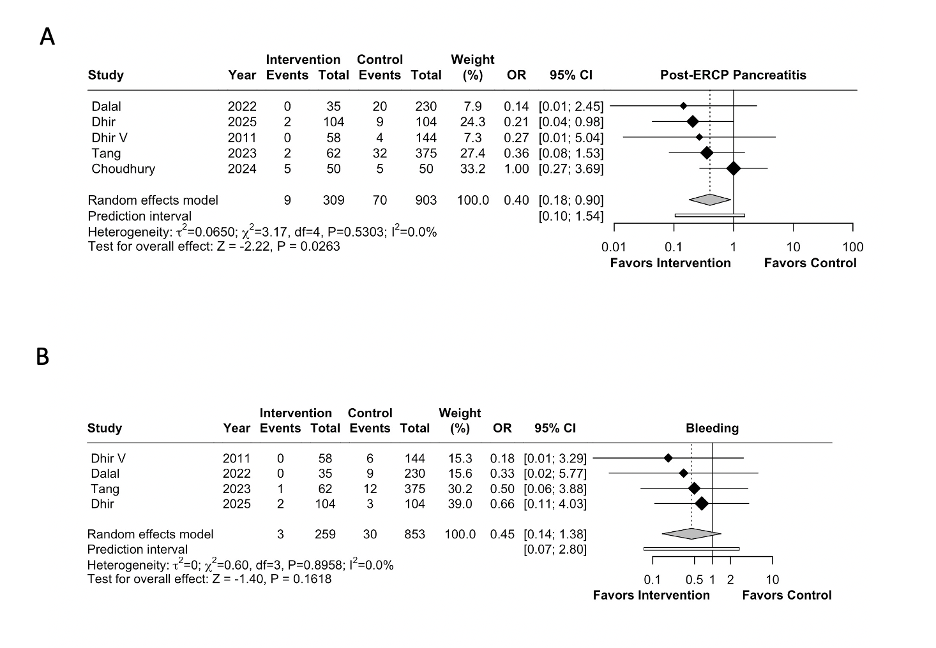Monday Poster Session
Category: Biliary/Pancreas
P2146 - Comparison of Endoscopic Ultrasound-Guided Rendezvous and Precut Papillotomy for Biliary Access: A Meta-Analysis of Randomized Trials
Monday, October 27, 2025
10:30 AM - 4:00 PM PDT
Location: Exhibit Hall

Gedion Yilma Amdetsion, MD (he/him/his)
Cook County Health
Chicago, IL
Presenting Author(s)
Chun-wei Pan, MD1, Gedion Yilma Amdetsion, MD1, Alexander Grieme, DO2, Hussein Baydoun, MD3, Marcello Maida, MD4, Marco Spadaccini, MD5, Azizullah Beran, MD3, Itegbemie Obaitan, MD, MPH3, Daryl Ramai, MD, MPH, MSc6
1Cook County Health, Chicago, IL; 2Baylor Scott & White, Round Rock, TX; 3Indiana University School of Medicine, Indianapolis, IN; 4Ruth Lilly Medical Library, Indiana University School of Medicine, Indianapolis, IN; 5Umberto I Hospital, Siracusa SR, Lazio, Italy; 6Brigham and Women’s Hospital, Harvard Medical School, Salt Lake City, UT
Introduction: When endoscopic retrograde cholangiopancreatography (ERCP) fails, alternative
techniques such as EUS-guided rendezvous (EUS-RV) and precut papillotomy are employed for
biliary access. This study compares the effectiveness and safety of these two approaches.
Methods: We conducted a comprehensive search in PubMed, Embase, Cochrane, and Web of
Science from inception until February 2025 for RCTs comparing EUS-guided rendezvous (EUS-
RV) and precut papillotomy. Primary outcomes included technical success rate, clinical success
rate, adverse events, and procedure time. Secondary outcomes included rate of post-ERCP
pancreatitis, bleeding, and length of hospital stay. A random effects model was used and the data
was presented using pooled odds ratios (OR) or mean differences (MD) with 95% confidence
intervals (CI).
Results: This study included 6 studies (4 retrospective cohort studies and 2 randomized
controlled trials) with a total of 1,415 patients. EUS-RV demonstrated significantly higher
technical success rates (odds ratio [OR] 2.69, 95% confidence interval [CI] 1.55-4.68, p=0.0004)
and a reduced risk of post-ERCP pancreatitis (OR 0.40, 95% CI 0.18-0.90, p=0.0263) compared
to precut papillotomy. No significant differences were found in overall adverse events (OR 1.09,
95% CI 0.35-3.38, p=0.8871), bleeding (OR 0.45, 95% CI 0.14-1.38, p=0.1618), or procedure
time (standardized mean difference [SMD] 0.42, 95% CI -0.98 to 1.83, p=0.5539).
Discussion: EUS-RV appears to offer superior effectiveness and safety for biliary access
following failed ERCP, with higher technical success and a lower incidence of pancreatitis.

Figure: Fig. 1. Forest plots of specific complications following EUS-RV versus precut sphincterotomy. (A) Post-ERCP pancreatitis. (B) Bleeding complications.
Disclosures:
Chun-wei Pan indicated no relevant financial relationships.
Gedion Yilma Amdetsion indicated no relevant financial relationships.
Alexander Grieme indicated no relevant financial relationships.
Hussein Baydoun indicated no relevant financial relationships.
Marcello Maida indicated no relevant financial relationships.
Marco Spadaccini indicated no relevant financial relationships.
Azizullah Beran indicated no relevant financial relationships.
Itegbemie Obaitan indicated no relevant financial relationships.
Daryl Ramai indicated no relevant financial relationships.
Chun-wei Pan, MD1, Gedion Yilma Amdetsion, MD1, Alexander Grieme, DO2, Hussein Baydoun, MD3, Marcello Maida, MD4, Marco Spadaccini, MD5, Azizullah Beran, MD3, Itegbemie Obaitan, MD, MPH3, Daryl Ramai, MD, MPH, MSc6. P2146 - Comparison of Endoscopic Ultrasound-Guided Rendezvous and Precut Papillotomy for Biliary Access: A Meta-Analysis of Randomized Trials, ACG 2025 Annual Scientific Meeting Abstracts. Phoenix, AZ: American College of Gastroenterology.
1Cook County Health, Chicago, IL; 2Baylor Scott & White, Round Rock, TX; 3Indiana University School of Medicine, Indianapolis, IN; 4Ruth Lilly Medical Library, Indiana University School of Medicine, Indianapolis, IN; 5Umberto I Hospital, Siracusa SR, Lazio, Italy; 6Brigham and Women’s Hospital, Harvard Medical School, Salt Lake City, UT
Introduction: When endoscopic retrograde cholangiopancreatography (ERCP) fails, alternative
techniques such as EUS-guided rendezvous (EUS-RV) and precut papillotomy are employed for
biliary access. This study compares the effectiveness and safety of these two approaches.
Methods: We conducted a comprehensive search in PubMed, Embase, Cochrane, and Web of
Science from inception until February 2025 for RCTs comparing EUS-guided rendezvous (EUS-
RV) and precut papillotomy. Primary outcomes included technical success rate, clinical success
rate, adverse events, and procedure time. Secondary outcomes included rate of post-ERCP
pancreatitis, bleeding, and length of hospital stay. A random effects model was used and the data
was presented using pooled odds ratios (OR) or mean differences (MD) with 95% confidence
intervals (CI).
Results: This study included 6 studies (4 retrospective cohort studies and 2 randomized
controlled trials) with a total of 1,415 patients. EUS-RV demonstrated significantly higher
technical success rates (odds ratio [OR] 2.69, 95% confidence interval [CI] 1.55-4.68, p=0.0004)
and a reduced risk of post-ERCP pancreatitis (OR 0.40, 95% CI 0.18-0.90, p=0.0263) compared
to precut papillotomy. No significant differences were found in overall adverse events (OR 1.09,
95% CI 0.35-3.38, p=0.8871), bleeding (OR 0.45, 95% CI 0.14-1.38, p=0.1618), or procedure
time (standardized mean difference [SMD] 0.42, 95% CI -0.98 to 1.83, p=0.5539).
Discussion: EUS-RV appears to offer superior effectiveness and safety for biliary access
following failed ERCP, with higher technical success and a lower incidence of pancreatitis.

Figure: Fig. 1. Forest plots of specific complications following EUS-RV versus precut sphincterotomy. (A) Post-ERCP pancreatitis. (B) Bleeding complications.
Disclosures:
Chun-wei Pan indicated no relevant financial relationships.
Gedion Yilma Amdetsion indicated no relevant financial relationships.
Alexander Grieme indicated no relevant financial relationships.
Hussein Baydoun indicated no relevant financial relationships.
Marcello Maida indicated no relevant financial relationships.
Marco Spadaccini indicated no relevant financial relationships.
Azizullah Beran indicated no relevant financial relationships.
Itegbemie Obaitan indicated no relevant financial relationships.
Daryl Ramai indicated no relevant financial relationships.
Chun-wei Pan, MD1, Gedion Yilma Amdetsion, MD1, Alexander Grieme, DO2, Hussein Baydoun, MD3, Marcello Maida, MD4, Marco Spadaccini, MD5, Azizullah Beran, MD3, Itegbemie Obaitan, MD, MPH3, Daryl Ramai, MD, MPH, MSc6. P2146 - Comparison of Endoscopic Ultrasound-Guided Rendezvous and Precut Papillotomy for Biliary Access: A Meta-Analysis of Randomized Trials, ACG 2025 Annual Scientific Meeting Abstracts. Phoenix, AZ: American College of Gastroenterology.
